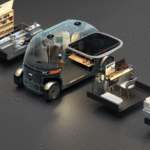With the increasing use of plastics due to 3D printing, there are some well-founded environmental concerns. An abundance of plastic items can be quite an issue, so biodegradable alternatives are always a major step forward. Still, the vast majority of printing applications use thermoplastics that cause a lot of damage. Deterred by this fact, designer Beer Holthuis came up with a solution: paper pulp printing. His work with the PaperPulpPrinter is a move forward for an easily reusable and environmentally friendly material.
Holthuis was rather unhappy with the lack of sustainable options for 3D printing so he investigated alternatives. Once he decided upon paper pulp as the primary waste product, Holthuis chose to develop a 3D printer especially for it. In total, human beings produce eighty kilos of paper pulp per person per year. This makes it a worthwhile and abundant by-product to use as a base material. The current model of the printer is quite basic, but it still provides a promising jumping off point.
Holthuis states that items made from paper pulp are surprisingly quite strong. Aside from their resilience, the materials provide the objects with a very natural and artisanal look, as though they were hand-woven. The process, particularly that of extrusion, is also surprisingly similar to that of FDM printing, other than using a binder to ready the material and dealing more with liquids and pressure.
Alternative Printing Materials
Holthuis takes standard paper pulp and mixes it in with a natural binder. As a result, they become recyclable once processed into a shape. The printer them extrudes the mixture through a syringe-like extruder from a pressure container. This process is rather simple and aside from being sustainable, it’s also potentially very inexpensive.
3D printing has seen major interest in the area of alternative environmentally friendly materials like hemp constructs or biodegradable plastics. Unlike those projects, however, this one uses paper pulp, which is a waste product in itself. This allows them to take the waste of one process and reuse that which is deemed worthless to create new prints. Additionally it makes prints that are reusable, so it adds an extra layer of utility to the whole process.
Featured image courtesy of Beer Holthuis.











